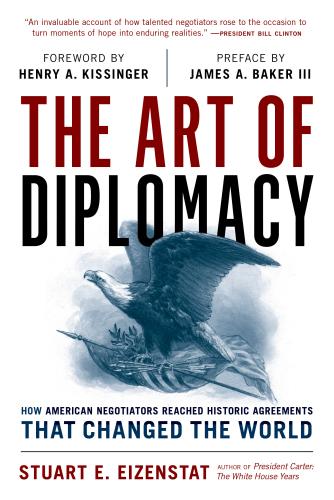A riveting retelling of diplomatic history with praise from Bill Clinton, Hillary Clinton, Bertie Ahern (Ireland), Tony Blair (UK), Ehud Olmert (Israel), and more. "A magisterial tome on the international negotiations that shaped modern American history.... Grand in scope and grounded in decades of experience,The Art of Diplomacyis a compelling work of political history aimed at the diplomatic negotiators of tomorrow."-Foreword ReviewsCommended byKirkus Reviews, which says Eizenstat writes with "authority and clarity of experience." Inside the greatest diplomatic negotiations of the past 50 yearsIn one readable volume, diplomat and negotiator Stuart E. Eizenstat covers every major contemporary international agreement, from the treaty to end the Vietnam War to the Kyoto Protocols and the Iranian Nuclear Accord. Written from the perspective that only a participant in top level negotiations can bring, Eizenstat recounts the events that led up to the negotiation, the drama that took place around the table, and draws lessons from successful and unsuccessful strategies and tactics. Based on interviews with over 60 key figures in American diplomacy, including former presidents and secretaries of state, and major political figures abroad, Eizenstat provides an intimate view of diplomacy as today's history.The Art of Diplomacywill be an indispensable volume to understand American foreign policy and provide invaluable insights on the art of negotiation for anyone involved in government or business negotiations.
Short Description
Stuart Eizenstat takes readers through an insiders guide to the greatest diplomatic negotiations of the past 50 years.
Table of Contents
Contents Foreword by Henry A. Kissinger Preface by James A. Baker III Introduction: The Value of DiplomacyPart One: The U.S. and National Security1: Henry Kissinger: Master Diplomat 2: German Reunification: James Baker Adds Two Plus Four 3: Iran: Negotiating with a Radical TheocracyPart Two: The U.S. As Mediator4: The Middle East: From Camp David to the Abraham Accords 5: Good Friday: George Mitchell and the Repair of a Divided Ireland 6: The Holocaust: Belated and Imperfect Justice 7: Unsung Heroes: Chester Crocker and Bernie AronsonPart Three: The U.S. at War8: The Balkan Wars: The Marriage of Force and Diplomacy 9: Afghanistan: From Victory to Failure 10: Iraq: A Tale of Two WarsPart Four: The U.S. in Multilateral Negotiations11: International Trade: Negotiating at Home and Abroad 12: Climate Change: The Supreme Test of Diplomacy Conclusion: Lessons on the Art of Diplomacy Notes Acknowledgments Index About the Author

